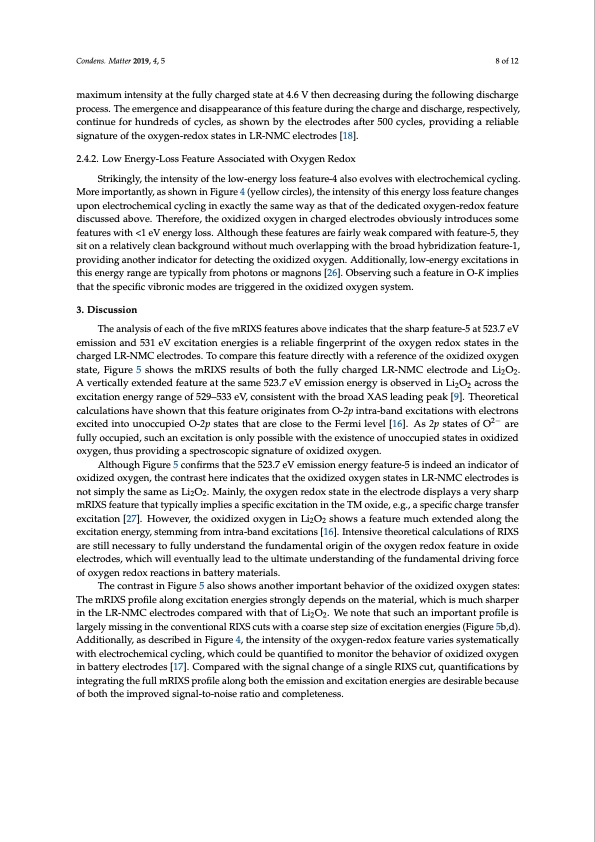
PDF Publication Title:
Text from PDF Page: 008
Condens. Matter 2019, 4, 5 8 of 12 maximum intensity at the fully charged state at 4.6 V then decreasing during the following discharge process. The emergence and disappearance of this feature during the charge and discharge, respectively, continue for hundreds of cycles, as shown by the electrodes after 500 cycles, providing a reliable signature of the oxygen-redox states in LR-NMC electrodes [18]. 2.4.2. Low Energy-Loss Feature Associated with Oxygen Redox Strikingly, the intensity of the low-energy loss feature-4 also evolves with electrochemical cycling. More importantly, as shown in Figure 4 (yellow circles), the intensity of this energy loss feature changes upon electrochemical cycling in exactly the same way as that of the dedicated oxygen-redox feature discussed above. Therefore, the oxidized oxygen in charged electrodes obviously introduces some features with <1 eV energy loss. Although these features are fairly weak compared with feature-5, they sit on a relatively clean background without much overlapping with the broad hybridization feature-1, providing another indicator for detecting the oxidized oxygen. Additionally, low-energy excitations in this energy range are typically from photons or magnons [26]. Observing such a feature in O-K implies that the specific vibronic modes are triggered in the oxidized oxygen system. 3. Discussion The analysis of each of the five mRIXS features above indicates that the sharp feature-5 at 523.7 eV emission and 531 eV excitation energies is a reliable fingerprint of the oxygen redox states in the charged LR-NMC electrodes. To compare this feature directly with a reference of the oxidized oxygen state, Figure 5 shows the mRIXS results of both the fully charged LR-NMC electrode and Li2O2. A vertically extended feature at the same 523.7 eV emission energy is observed in Li2O2 across the excitation energy range of 529–533 eV, consistent with the broad XAS leading peak [9]. Theoretical calculations have shown that this feature originates from O-2p intra-band excitations with electrons excited into unoccupied O-2p states that are close to the Fermi level [16]. As 2p states of O2− are fully occupied, such an excitation is only possible with the existence of unoccupied states in oxidized oxygen, thus providing a spectroscopic signature of oxidized oxygen. Although Figure 5 confirms that the 523.7 eV emission energy feature-5 is indeed an indicator of oxidized oxygen, the contrast here indicates that the oxidized oxygen states in LR-NMC electrodes is not simply the same as Li2O2. Mainly, the oxygen redox state in the electrode displays a very sharp mRIXS feature that typically implies a specific excitation in the TM oxide, e.g., a specific charge transfer excitation [27]. However, the oxidized oxygen in Li2O2 shows a feature much extended along the excitation energy, stemming from intra-band excitations [16]. Intensive theoretical calculations of RIXS are still necessary to fully understand the fundamental origin of the oxygen redox feature in oxide electrodes, which will eventually lead to the ultimate understanding of the fundamental driving force of oxygen redox reactions in battery materials. The contrast in Figure 5 also shows another important behavior of the oxidized oxygen states: The mRIXS profile along excitation energies strongly depends on the material, which is much sharper in the LR-NMC electrodes compared with that of Li2O2. We note that such an important profile is largely missing in the conventional RIXS cuts with a coarse step size of excitation energies (Figure 5b,d). Additionally, as described in Figure 4, the intensity of the oxygen-redox feature varies systematically with electrochemical cycling, which could be quantified to monitor the behavior of oxidized oxygen in battery electrodes [17]. Compared with the signal change of a single RIXS cut, quantifications by integrating the full mRIXS profile along both the emission and excitation energies are desirable because of both the improved signal-to-noise ratio and completeness.PDF Image | Oxygen Redox Reactions in Batteries Resonant Inelastic X-ray Scattering

PDF Search Title:
Oxygen Redox Reactions in Batteries Resonant Inelastic X-ray ScatteringOriginal File Name Searched:
condensedmatter-04-00005.pdfDIY PDF Search: Google It | Yahoo | Bing
Sulfur Deposition on Carbon Nanofibers using Supercritical CO2 Sulfur Deposition on Carbon Nanofibers using Supercritical CO2. Gamma sulfur also known as mother of pearl sulfur and nacreous sulfur... More Info
CO2 Organic Rankine Cycle Experimenter Platform The supercritical CO2 phase change system is both a heat pump and organic rankine cycle which can be used for those purposes and as a supercritical extractor for advanced subcritical and supercritical extraction technology. Uses include producing nanoparticles, precious metal CO2 extraction, lithium battery recycling, and other applications... More Info
| CONTACT TEL: 608-238-6001 Email: greg@infinityturbine.com | RSS | AMP |